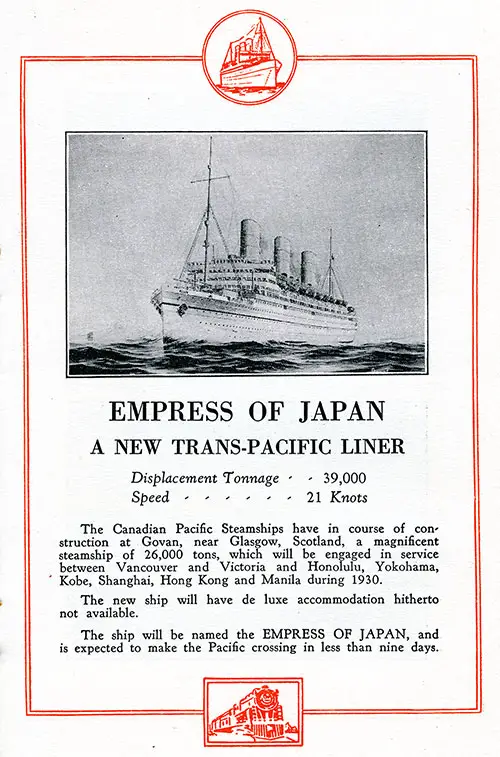SS Empress of Japan Archival Collection
Empress of Japan (1890) Canadian Pacific Line.
Built by Naval Construction and Armaments Co., Ltd., Barrow. England. Tonnage: 5,940. Dimensions: 455'x 51'. Propulsion: Twin-screw. 18 knots. Triple expansion entities. Masts and Funnels: Three masts and two funnels. Additional Features: Steel hull. Launched December 13, 1890. Attained a speed of 18.91 knots on her trials. Speed Records: It held the trans-Pacific speed record for a number of years until the Empress of Russia bettered it. In service Vancouver-Hong Kong 1891-1914 and 1915-1922. War Service: Served as auxiliary cruiser during the 1914-1915 period. Fate: Scrapped in l926. Sister ships: Empress of China and Empress of India.
Empress of Japan (1930) Canadian Pacific Line.
Built by Fairfield Shipbuilding and Engineering Co., Ltd. Govan, Scotland. Tonnage: 26,032. Dimensions: 644' x 83' (666' o.l.). Propulsion: Twin-screw, 22 knots. Turbines. Masts and Funnels: Two masts and three funnels. Speed Records: Her maximum trial speed was 22.38 knots. Held the trans-Pacific speed record. Made the crossing from Yokohama to Vancouver in 8 days, 6 hours, 27 minutes. Additional Features: From keel to navigating bridge 98 feet. Launched: She was launched on December 17, 1929. Completed in June 1930. Renamed: (a) Empress of Scotland (1942), (b) Hanseatic (1958).
The Empress of Japan (1930), the finest, largest, and fastest passenger ship the Canadian Pacific had in Pacific service, was a luxury liner built in 1930. On her maiden voyage from Vancouver to Yokohama, she not only broke the speed record for the run but also set a new standard, making it in an impressive 8 days, 6 hours, and 27 minutes. This remarkable feat was later surpassed by the same ship. In 1941, the Empress of Japan was renamed Empress of Scotland due to Japan's entry into the war against the Allies. After World War II, this magnificent liner was thoroughly reconditioned for their trans-Atlantic service. Today, the Canadian Pacific Railway stands as the world's most significant transportation organization, thanks in part to the legacy of the Empress of Japan.
Based on a discussion of Trans-Pacific Passenger Ships (Part II) in Passenger Ships of the World, Past and Present, by Eugene W. Smith, 1963.

Empress of Japan, a New Trans-Pacific Liner. Displacement Tonnage 26,000, Speed 21 Knots. SS Empress of Canada First and Second Class Passenger List, 12 June 1930. | GGA Image ID # 2173c21a61
The Canadian Pacific Steamships Are in the Process of Construction at Govan, Near Glasgow, Scotland, of a Magnificent 26,000-Ton Steamship That Will Be Engaged in Service Between Vancouver and Victoria and Honolulu, Yokohama, Kobe, Shanghai, Hong Kong, and Manila During 1930. the New Ship Will Have deLuxe Accommodation Hitherto Not Available. the Vessel Will Be Named the Empress of Japan and Is Expected to Make the Pacific Crossing in Less Than Nine Days. NOTE: The "39,000 Displacement Tonnage" was a Typo. The Empress of Japan Displaced 26,000 Tons.
